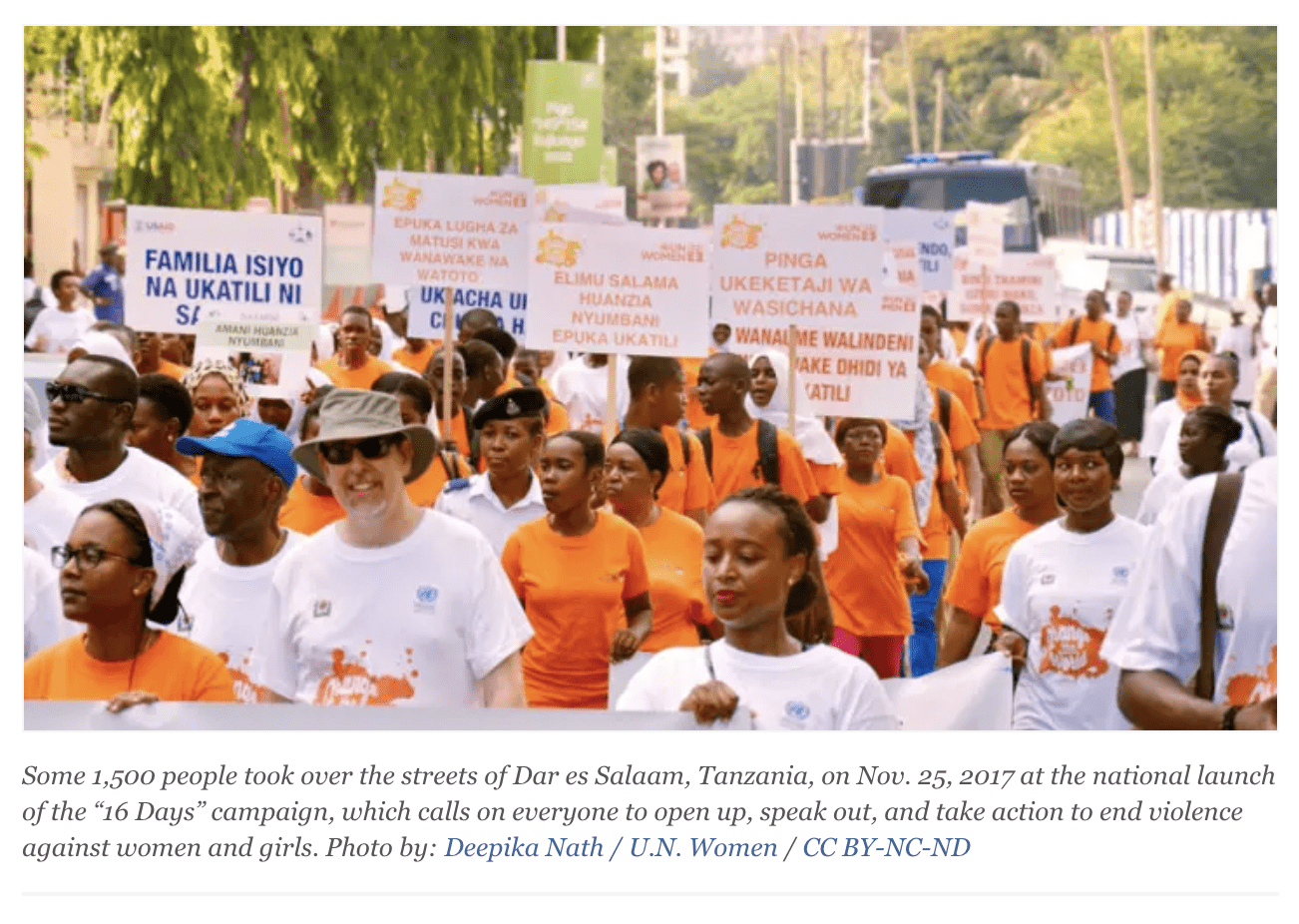By devex editor
When the government of Tanzania launched a national study on violence against children in 2009, the results were shocking. Nearly a third of surveyed females said they had experienced sexual violence before the age of 18. Among the respondents, 31 percent became pregnant as a result of that violence, and almost three-quarters of females had experienced physical violence by an adult or intimate partner as a child. These acts of violence were shown to have long-term repercussions on respondents’ health, such as increased HIV prevalence and mental health issues.
“It’s about shifting the way that all the different stakeholders within the decision-making chain [think] about what data is and where it should lead to.”
— Emily Courey Pryor, executive director, Data2X
The survey results persuaded the government to launch a National Plan of Action to End Violence Against Women and Children in Tanzania in 2016. There are now 40 police desks — staffed with officers trained to deal with violence against women and children — across the country, thousands of judges and prosecutors trained to handle sensitive cases, and postrape health services for youth have been strengthened across the country.
Tanzania’s fight against gender-based violence is hailed as an example of how data can be used to drive policymaking.
“Data is critical to driving global change and enabling the kind of positive decisions and policies we need for progress; however, because we don’t always see the data, the collection and use [of] pieces aren’t always prioritized,” said Emily Courey Pryor, executive director of Data2X, a collaborative technical and advocacy platform dedicated to improving the quality, availability, and use of gender data in order to make a practical difference in the lives of women and girls worldwide.
More and better data
The scope of gender-based violence remains largely unknown in many countries. Taboos surrounding sexual and domestic violence, a lack of available services, and fraught justice systems can prevent victims from speaking up and seeking care in a majority of cases.
However, collecting good data is often the first step toward diagnosing this often-undetected problem. The study conducted by Tanzania to assess the magnitude of violence against children in 2009 made it the first African country to do so.
There is a growing interest in investigating the prevalence of violence against women: 89 countries conducted a violence against women survey between 2005-2014 — double the number of countries that did so during the previous 10 years.
From data to action
Still, simply collecting the data isn’t enough. Data must be high-quality and comparable to ensure that it gets used to improve policies and outcomes.
There are calls to disaggregate data by age, geographical location, income, and more, to reveal a more complete and nuanced picture of the realities faced by victims. To ensure that violence against women data is comparable across the world, in 2011, the United Nations Statistical Commission adopted nine standard indicators for measuring violence against women, and the Sustainable Development Goals contain a specific target and three related indicators regarding violence against women, an important step for recognizing the importance of violence against women data.
Equally important is the need to ensure data collection eventually leads to impact in terms of policies being created or improved, programs being implemented, and ultimately, violence decreasing. However, in many cases, the data never reaches the right hands.
In a survey conducted by Equal Measures 2030 last year, most policymakers admitted to being uncertain about the scale of certain key issues faced by women in their countries, and where to access the corresponding information.
That’s because data producers and data users often work in isolation from each other, Courey Pryor explained.
“I think it’s about shifting the way that all the different stakeholders within the decision-making chain [think] about what data is and where it should lead to,” Courey Pryor said.
“All of us, whether we sit on the technical side of data production or on the policymaking side of data use, benefit from the whole chain being strong.”
Increasing engagement, ensuring ownership
One way to encourage data use is to include data users in the conversation from the start. This was a key finding in the work conducted by Data2X and Open Data Watch in collecting gender impact stories. This work sought to showcase how quality gender data can lead to informed policies and programs, and found that in all cases where data successfully led to impact, end users were brought in early in the process.
Tanzania’s Violence Against Children Survey demonstrates the same finding, explained Daniela Ligiero, CEO at Together for Girls, a global public-private partnership dedicated to ending sexual violence against girls. The Violence Against Children Survey was guided by a multisectoral taskforce comprised of government ministries and departments — ranging from justice to health, education, and social protection — as well as local and international development partners.
According to Ligiero, major policy changes occur when stakeholders are involved as early as possible. Together for Girls conducts surveys specifically at the request of governments so as to ensure ownership of the data, and — only when a commitment has been made — to subsequently develop a response plan, she explained.
“One of the most important things about this is the process of working with a variety of partners from the very beginning,” she said. “We’ve been able to work in countries where many people said it would not be possible to do so because of this methodology, and we now have data for 10 percent of the world's children and youth [collated] in only 10 years.”
Making the data speak
Like Tanzania, data was a driver for Vietnam to take action on violence against women — another story that emerged from Data2X and Open Data Watch’s gender data impact story collection.
In 2009, the Vietnamese government, with support from the World Health Organization, United Nations Population Fund, and a variety of international and local partners, surveyed 5,000 Vietnamese women about their experience with domestic violence, and as in Tanzania, the results were surprising to government officials. The findings showed that 58 percent of respondents reported having been physically, sexually, or emotionally abused by their husbands. 87 percent hadn’t sought any form of help.
“These were shocking figures to the government,” recalled Ha Thi Quyn Hanh, program specialist, human rights and gender, at UNFPA Vietnam. “They didn’t believe there was such a high rate of violence in Vietnam.”
Since then, the data has been used to influence policy development and programming, culminating in a National Action Plan on Gender Based Violence 2017-2021. Women and girls in Vietnam can now access a range of counseling, health, and legal services, and find shelter in a network of community safe houses.
This was the result of an arduous effort on the part of development and community actors to convince government leaders across relevant ministries and agencies to take action.
“That was a very long process. We couldn’t push the government to believe in our findings, or to use our findings right from the beginning,” Ha Thi said.
Researchers from UN Women estimated the cost of domestic violence against women — both direct and indirect — to provide a further incentive for the government to act.
It also took multiple advocacy and campaign efforts — including producing a video featuring testimonials of domestic violence survivors — and taking government officials on a multicountry tour to observe the impact of programs designed to address gender-based violence on the ground, for large-scale action to take place.
“At the beginning, the government didn’t use the findings of the study. But after several years, they started quoting the evidence in their events and in their speeches,” Ha Thi said.
Data on solutions
Producing evidence on effective interventions is the next step in using data to fight violence against women, and gender-based violence at large, Together for Girls’ Ligiero explained. Governments and development actors need to know which interventions are working well, in order to make the case for increased investments. “We’ve progressed on data on the problems, and now we need to do a lot more on data for solutions.”
Ha Thi agrees. Vietnam is currently preparing its second survey on domestic violence, which will help the government assess the efficiency of policies and programs put in place since domestic violence was first exposed as a nationwide issue.
This time, a steering committee will coordinate the survey, comprised of representatives from different government agencies responsible for gender equality and domestic violence. Each member agency has already committed to using the results of the upcoming survey to update policies and programs, thus ensuring a greater degree of ownership, Ha Thi explained.
“The International Day to Eliminate Violence Against Women focuses global attention on a terrible global problem,” said Data2X’s Courey Pryor. “When we consider all the ways we need to take action, it is important to shift our understanding of data from a background player to a necessary driver for change.”
“The gender data impact stories from Tanzania and Vietnam demonstrate data’s role in addressing the problem head-on: showing how countries can undertake data collection sensitively and use that data for better policy decisions to improve the lives of women and girls.”




